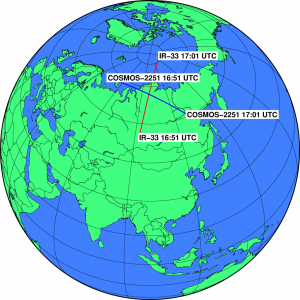It was reported that an Iridium satellite and an “non-functional Russian satellite” collided yesterday. I was curious, so I did a bit of digging, and found out that NASA had reported that it was Iridium 33 and COSMOS-2251. A bit more work uncovered orbital elements for both objects, so I was able to plug in their numbers and determine the location of the collision. A bit more of scripting, and I had GMT generate the following map (click to zoom in some more):
According to my calculations, they passed within 100 meters of one another (but my code gives an uncertainty much greater than that.) Each satellite is travelling about 26,900 km/second hour (sorry for the typo, but the math holds). I don’t have the mass numbers for the satellite, but even if you think they are travelling at perfect right angles, each kilogram of the mass generates about 28M joules of energy. According to this page on bird strikes, a major league fastball is about 112 joules, a rifle bullet is about 5,000 joules, and a hand grenade is about 600,000 joules. This collision generated 28M joules per kilogram of mass. Ouch!
Addendum: It’s been a long time since I took basic physics. If you care, you shouldn’t trust my math, you should do it yourself and send me corrections. 🙂

I found an animated version of the map at http://community.livejournal.com/randompictures/5677534.html — though to get posted there it was probably taken from somewhere else. I guess the circles represent how much of the earth’s surface they can see from that altitude?
Low-Earth orbital velocity is about 8 km/s. So the two satellites could not have collided with a relative velocity greater than about 16 km/s, if they approached each other head-on.
Physically the least complicated way to analyze such a collision would be to use the collision point as the center of reference and consider the two satellites both approaching it at 8 km/s from different directions. Conservation of momentum will pretty much tell you how the resulting debris cloud will move as a whole. Relative to the collision center the kinetic energy of the satellites would be about 64M J/kg ((8000 m/s)^2) but some of that will be lost to deformation of the debris and heat so the total kinetic energy of the debris cloud will be somewhat less than that.
It seems the most likely scenario is that the satellites collided off-center, causing some immediate debris spatter from the impact and setting the remaining satellite bodies spinning, perhaps rapidly enough to break up further.
I agree, although I think kinetic energy is 1/2 m v2, so you are off by the a factor of two I think. In the case I was hypothesizing, the satellites collide at right angles (approximately correct in the geometry above), so the closing velocity is just about the orbital velocity. Even a glancing blow would likely involve several kg of mass interacting, and that would be very bad. 🙂
Thanks for the link David, I hadn’t worked out where the terminator was at the time. Probably was a pretty good show for those in Siberia who were looking up. 🙂 Yeah, I think the circles are the region over which the satellites would have been above the horizon (my code can compute that too, maybe I’ll do that later).
By the way, I like your page on Egyptian Fractions, as I noted before. Ecstatic to see you reading my blog too. I’m flattered!
Umm, right, m*v^2/2. 32 MJ/kg is still a lot.
It also occurs to me that an even better way to analyze the collision is to use a center-of-momentum reference frame. So if the two satellites approach at about a 90-degree angle, then the closing velocity is about sqrt(2)*8 km/s (interestingly, escape velocity from a circular orbit is sqrt(2) times the circular orbit velocity).
It sounds like neither satellite was of a size to be easily naked-eye visible when the Sun is below the horizon but shining on the satellites (if you’ve ever seen an Iridium flare, you may notice that it’s pretty hard to find the satellite before or after the flare). There might have been a small flash from the collision, but I suspect the better light show would come a little while afterward when the downward-deflected collision debris entered the atmosphere.
It also looks to me like the collision geometry is such that much of the debris (including any large chunks of satellite that survived the collision) probably wouldn’t last more than another half-orbit before dropping into the atmosphere. But there are probably lots of little pieces that are in longer-lived orbits some of which pass through the orbital altitude of the ISS and shuttle flights.
A ton of TNT yields about 4173 megajoules, or about 150 Kg worth by your estimate. A ton of TNT is a really big explosion, there wouldn’t be any large pieces left. The famous Mythbusters cement mixer blowup only used 850 pounds (.425 tons) of TNT and even so there wasn’t much of the truck left. (Uh, I’m not sure the explosive they used was TNT, but certainly something comparable.)
I just keep seeing the scene in “Wall-E” with all the orbital debris…
32 MJ/kg is 8 million calories per kg. To raise 1 kg of
water 1C, you need 1000cal, right? So you can raise the
temp of water to 1000C.
Water has a high specific heat. Wouldn’t most substances
melt, vaporize, or decompose at those energy densities?
The Bad Astronomer has a pretty detailed calculation on the collision energy.